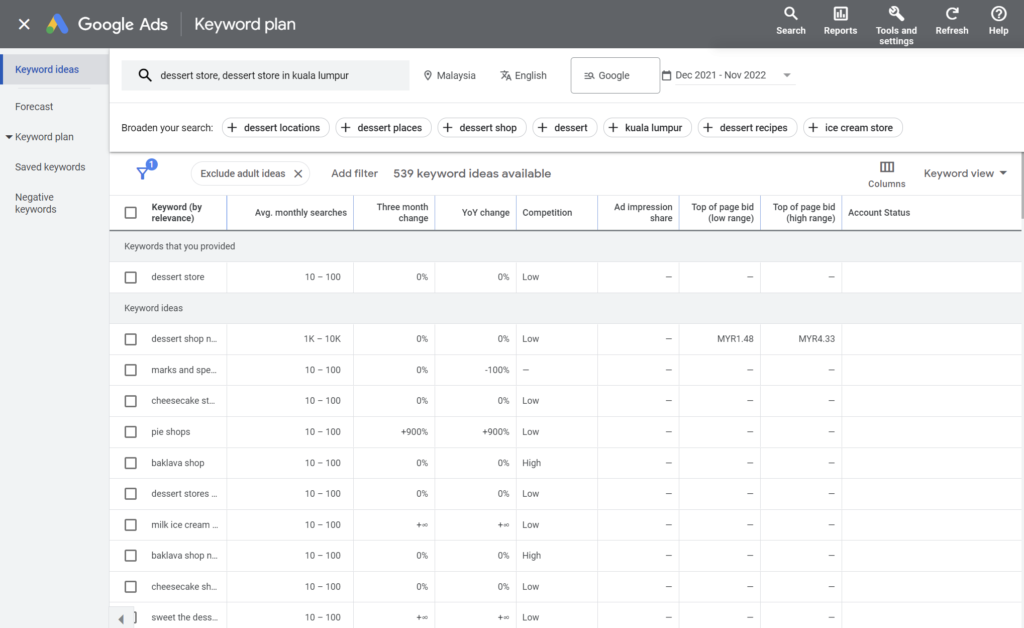If you ask any digital marketers their thoughts on SEO, they will usually respond — SEO isn’t what it used to be. In other words, SEO has become more than just using keywords to rank up your web pages or content on search engines.
Though the foundation of SEO remains the same; to use keywords to increase your web pages or content visibility on search engines, there are actually other ways besides relying solely on keywords.
Although most businesses nowadays understand the foundation of SEO, how SEO works and why it’s vital for their business. They remain unable to execute a sound SEO strategy because they are too focused on creating content based on the keywords their target audience will search for on the Internet.
What is an SEO Strategy?
First, we will need to understand what is an SEO strategy and how it works.
An SEO strategy is a process of organising a website’s content by topic and keywords to improve visibility and likelihood of appearing in search results. To put it simply, it is a process that you follow and use to maximise and also increase the opportunity to gain organic traffic from search engines.
By having an SEO strategy, your content creation will stay on point and relevant to what people search for on the Internet. It is because, during content creation, you create content that people are searching for, not what you think people are searching for on the Internet.
Simply put, your content is what people look for — relevant and have the solutions people look for, not just a bunch of keywords stuffed into content for the sake of increased visibility and likelihood of appearing in search engines.
SEO strategy is a vital part of content marketing because it is the thing that determines your content visibility on search engine result pages (SERPS). So if your content topic is scattered and doesn’t contain relevant keywords, the search engine bots will have a hard time indexing your site, identifying your area of Authority and ranking your site pages.
What is an SEO?
SEO stands for search engine optimisation, a method to optimise your website to help it rank higher on SERPS and drive more organic traffic to your website. The individuals with the skills to pull off SEO are called SEO Strategists. In other words, they are specialised content strategists that help businesses become more discoverable on search engines and provide opportunities to answer questions people have about their current issues or industries.
There are three areas that an SEO Strategist can work on:
On-page SEO:
On-page SEO is a method that focuses on optimising all pages on-site by including relevant content and specific keywords that help boost a website’s ranking.
Off-page SEO:
The off-page SEO focus on direct links to your website from elsewhere on the Internet, these links are called backlinks, and the number of backlinks a site has from reputable sources helps to build your website’s trust with search algorithms.
In simpler terms, backlinks are hyperlinks linking to your website from other websites. These backlinks are usually from websites that cited your website as a reference in their content.
Technical SEO
Technical SEO focuses on the backend architecture of your website, such as site code, site speed, page flow, etc. It is because Google cares about the backend and other technical aspects as much as content quality and relevancy.
Also, since every business has different objectives — it is up to SEO Strategists to examine the industry and identify the right audience and what they care about before they can deliver a strategy that can yield the right results.
This brings us to the next point; explore the steps you can take to ensure your SEO strategy is effective.
Make a list of topics
Though keywords are SEO’s core, they are no longer the bread and butter to organic growth for your website. For the first step, you will want to make a list of topics that are relevant to both your business and target audience. The content will be able to address your target audience’s concerns or questions.
Start by compiling a list of keywords that are relevant to your business, services or products. You can use SEO tools such as Google Keyword Planner, Ahrefs, or SEMRush. These tools will help to research the keywords’ search volume and other variations that you can use.
The keywords search volume will determine how easy or difficult you have to compete to rank your content against other content using the same or similar keywords. As for the variations, you will want to use popular short-tail keywords that can be associated with your

Okay, here’s an example. Let’s say a dessert store is trying to rank “dessert store”, which receives over 10,000 searches per month – this short-tail keyword can be used as the core or theme for the content topic. This short-tail keyword can be expanded into different variations so that you can include it in content without using the same keyword repeatedly. For example, they can use variations such as these; “dessert store near me” or “dessert store in KL”. These keyword variations are also utilised to gain additional rankings.
You can use search volume and competition to gauge keyword performance; so that you can create a list of 10-15 short-tail keywords that are relevant to your business and most searched by your target audience. Then you can rank this list based on monthly search volume.
The keywords you have identified are called pillars and serve as the primary support for a larger cluster of long-tail keywords.
And this brings us to the second point of this guide.
Make a list of long-tail keywords based on the topics you have established

This is the step where you will begin optimising the pages on your website for the keywords in your list. Begin with using keyword research tools to expand the pillars — identify 10 long-tail keywords for each pillar. It will provide you with more keyword variations and dig deeper into the original topic keywords. Thus, adding more topics that are relevant to your target audience.
Here’s another example; you regularly create content about digital marketing, but it is difficult to rank well on Google for such general and popular keywords. In addition, you will also risk targeting the wrong audience and competing with your other content or pages that are using the same keywords.
So, to avoid that from happening, you can create content on digital marketing strategy, how to start your own digital marketing business, digital marketing consultations or any other subtopics under digital marketing.
This will help your business to attract audiences with varying interests and concerns about digital marketing — creating more entry points for people to start taking interest in your business and its services.
The long-tail keywords also can be used in your blog posts or web pages to help provide an explanation or introduction to your business or the specific topics you have selected in the pillar.
So, the more specific and varying your content is; the more likely your content able to address the target audience’s interests or issues and the more likely you convert the audience (traffic) into leads.
In addition, it will also help the Google algorithm have an easier time connecting your content when all of your long-tail keywords create a cluster (subtopics) around the pillar (main topic/keyword).
Build a dedicated page for each topic
The Internet is very competitive, especially when you are getting a page to rank a handful of keywords — it feels almost impossible to see the keywords rank move. Fortunately, there is a way to make your keywords rank easier.
You can use the pillars you came up with to create a page or post that can give an overview of the topic using the long-tail keywords. The pages created using the pillars can be a table of contents for a page or a blog post — where you provide an introduction and description for the main topic and elaborations for other subtopics within the page or post.
However, be sure the number of pillars you created coincides with the number of services or products your business offers. The reason for this is — it will make it easier for current customers and prospects to find your business in search engines no matter what keywords they use (as long as the keywords are in the same category as your business.
Establish a blog page
Blogging is one of the most effective ways to rank your keywords and, at the same time engage your website’s visitors. This is because a blog page is considered a new webpage and provides your website with an additional opportunity to rank on SERPs. A solid reason for your website to have a blog page.
When you are writing your blog page and expanding on your clusters, remember to do these three things:
Don’t include or repeat long-tail keywords more than three or four times
This is because Google doesn’t consider exact keyword matches as often as it used to. Also, too many instances and aggressive use of keywords can be seen as a red flag by search engines — that you are keyword stuffing to gain rankings. If the search engines detect or view your actions as keyword stuffing, your content, web pages, or the website itself could be penalised.
Link out to the pillar pages you have created
To link back to the pillar pages — you can use the tags in your content management system (CMS) or as anchor texts in the body of an article.
Link back to the parent pillar page
After you have published a blog post on your web page, link back to the pillar page that supports the subtopic — to tell Google that there is a connection between the long-tail keywords and the topic you are trying to rank.
Create a blogging schedule
Though it is important to relate your blog post to the topic clusters — it doesn’t mean you have to do so every time you publish a blog post on your website. You should know there is also value in writing a relatable blog post for your audience reading, which helps build authority with the Google algorithms.
Thus, at least once a week, you should write a blog post for audience reading, not search engines — so you will want to do some fact-checks and market research beforehand, which will help you to write interesting and relevant blog posts.
Make a plan for your link building

Though topic cluster is the best way forward, it is not the only method you can use to push your website content to rank higher.
In SEO, on-page optimisation is the first and must-do step. However, there is also off-page link building — a process of attracting inbound links or, more commonly known as backlinks, to your website from other sources on the Internet (typically mentions from other websites). The rule of thumb is to have websites with high authority linking back to your website before you can see a significant impact on rankings.
You can start by approaching other blogs for guest blogging, which provide the opportunity to be mentioned and link back to your website. You also can start by exchanging links with local businesses; have them mentioned and link back to your website while you do the same for them — you can write a few blog posts mentioning their business and share the articles on different platforms. These are some of the ways that you can utilise to attract inbound or backlinks from high-authority websites to your website.
Compress media files
It may seem like a small thing to do it has a significant impact on your optimisation process, especially for mobile.
As you write and create more content for your website’s blog page, there’ll be more media files such as images, and videos. And these media files can affect your website load speed. Page load speed is a crucial ranking factor for both rankings and visitor retention. If a page load speed is slow, visitors will likely close the page — which increases the rebound rate. Though the rebound rate doesn’t directly affect organic ranking, it is however indirectly affecting other ranking factors Google cares about, such as page speed, quality and mobile optimisation.
That is why you need to be aware of all media files size on a page. The bigger the file size, the longer it will take for the browser to render the page. It is even harder for a mobile browser to render when the media file size is big. This is because the bandwidth for mobile devices is significantly smaller than for desktops or laptops.
So before uploading and publishing content, you can use a compression tool to reduce the media files size. You visit sites such as TinyPNG to compress images in bulk or if you want to compress images that you already have uploaded — you can download and install Smush on your website, it will compress all of the images on your website.
If you wondering what are the ideal sizes are for media files, the answer would be that you should keep them in the kilobytes range. You can upload media files in megabytes, but not all and every single media file.
Stay in the loop with SEO updates and best practices
Much like everything else, the SEO landscape is ever-changing and evolving; almost every day there will be new updates, discoveries or breakthroughs. That is why you need to stay on top of things — so that you can implement the latest SEO best practices as a part of your digital marketing strategies.
There are many resources available to help you stay up-to-date;
Track and measure your success

SEO requires a lot of time and effort, so it is only natural that you want to know if the SEO strategy you have executed was effective. To see the effectiveness of your SEO strategy, you can start by tracking and measuring the metrics — it will help you to understand the overall performance and process, and also help you to identify the areas needing improvement.
As for tracking organic traffic, you can use any web analytics tools or create a dashboard of your own using Google Sheets or Microsoft Excel. You would also want to track indexed pages, ROI, conversion rates and rankings on SERP as it will help you to identify opportunities and what works, and what doesn’t work.
SEO Report
Besides tracking and measuring your success using tools, you would also want to compile SEO reports for all the SEO strategies you have executed. It is the documentation of all the success your SEO strategies have achieved and the areas that need improvement. Besides that, a consolidated SEO report also helps when presenting SEO data to clients or stakeholders — to show why SEO is important and how it the SEO activities you have done can grow their business.
The SEO report should contain metrics like organic traffic results, SEO performance and health of the website, inbound link (backlink) generation, and the areas needed to be addressed before they are declined any further.
However, to have an SEO report you will first need to execute and complete successful SEO activities. To help you understand what is a successful SEO activity, we will share a few examples.
Successful SEO activities example
In this sub-section, we will go over some examples of what SEO activities look like in practice.
Compelling and interesting meta description
Writing a meta description may seem like an insignificant and small task, but it is quite challenging.
It is because you have to write a compelling and interesting short write-up that explains the content of your web page and is attention-grabbing at the same time. In addition, you will need to include some of the relevant keywords.
Besides letting visitors know the content of your web page, meta description also lets Google know the contents of your web page and helps the said web page to appear in the correct and relevant search results. Thus, increasing the chances of your website or web page being discovered by relevant visitors.
Content inbound links (backlinks)
A backlink or an inbound link is a string of text embedded with a link to your website. It is an effective way to push your content rankings on SERPs because they inform search engines that your content is relevant and has authority.
Optimise your website page speed
In 2018, Google began taking page speed into account for SERPs rankings — making it one of the critical parts to focus on when executing your SEO strategy. That is why we explored media file compressing; to optimise your website page speed.
In addition, the faster your website page load, the longer visitors will stay on your website page.
Local SEO
Pushing keywords to rank on global SERP is all well and good, but don’t forget about local SEO — the main source of organic traffic for your website and the visibility of your business location to nearby potential customers.
So, be sure to update your SEO strategy for the local area as well. It will help nearby potential customers find your business location easily when they make a search relevant to your business.
Here’s an example of good local SEO. As you can see, when I Googled “bakery near me”, the results show that there are four bakeries near me and their location.
Establish an SEO process
SEO strategy is an ongoing process. Though you have established a strategy and executed it, you will still need to continue optimising the keywords for the ever-evolving search intent. Here are some of the steps you can take and use;
Historically optimise content
Try to find time to update your old blog posts with new and updated information to help to continue ranking in SERPs. You can also use this as the time to add previously missing SEO best practices such as missing image alt texts, compressed media file size, etc.
Be aware of new keywords and new search intent
As we’ve mentioned before, SEO is ever-changing and evolving, so you will need to be aware of new keywords and how people search for them. You can do this by backtracking how posts rank and which keywords they rank for. This will help you adjust the title, subheading and copy to leverage the new search intent.
Refresh and add more editorial value to your old content
You can go beyond historical updates for your content. For example, you can update date information, add new sub-sections or update the data graph so that your content remains relevant to both search engines and searches. This will help you gain more referral traffic because searchers find that the information in your content is relevant and up-to-date.
Have a monthly content plan
To further smoothen your SEO execution, you can create a monthly content calendar. This will help you to execute a more efficient SEO strategy. You will also be able to identify hot topics currently going on in your industry and use them as content.
Create an SEO strategy that aligns with your business
Though you may identify keywords with high search volume and build content based on those high search volume keywords, it may not be aligned with your business needs and goals.
Instead, you can try an SEO strategy that aligns with your current business needs, such as increasing conversion rate or customer acquisition.
However, it may be hard and challenging to do this on your own. So why not contact an expert to help you to come up with a sound SEO strategy that aligns with your business?
Experts like us, SEO Solutions, specialising in data-driven marketing and using SEO to increase your website traffic and visibility on SERPs.
Get a free consultation for your first consultation with us.






